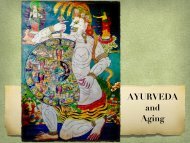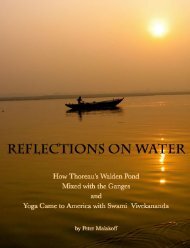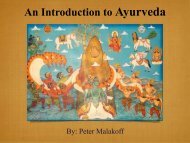How Thoreau's Walden Pond Mixed with the Ganges and Yoga Came to America with Swami Vivekananda
One early morning in 1846, during the coldest days of a New England winter, Henry David Thoreau looked out the window of his small cabin on Walden Pond and saw men cutting its ice into blocks. That ice was hauled by horse to a railroad that ran across the western edge of Walden Pond, packed into a boxcar, taken to Boston and loaded onto a clipper ship that sailed to Calcutta, India, arriving about four months later. Once there, that ice was purchased by grateful members of the East India Company. Thoreau had witnessed a small part of the global ice trade between New England and India that took place during the latter part of the nineteenth century. When Thoreau considered the ice trade, his vision sailed on metaphors far beyond the scope of business. The waters he imagined flowed both east and west and carried not just natural elements, but culture, religion and philosophy as well. He envisioned that after arriving in Calcutta, the New England ice of Walden Pond would eventually melt and run downhill where it would join with the sacred water of the Ganges. He wrote in Walden: "It appears that the sweltering inhabitants of Charleston and New Orleans, of Madras and Bombay and , drink at my well. In the morning I bathe my intellect in the stupendous and cosmogonal philosophy of the , since whose composition years of the gods have elapsed, and in comparison with which our modern world and its literature seem puny and trivial; and I doubt if that philosophy is not to be referred to a previous state of existence, so remote is its sublimity from our conceptions. I lay down the book [Bhagavad-Gita] and go to my well for water, and lo! there I meet the servant of the Bramin, priest of and and who still sits in his temple on the Ganges reading the , or dwells at the root of a tree with his crust and water jug. I meet his servant come to draw water for his master, and our buckets as it were grate together in the same well. The pure Walden water is mingled with the sacred water of the Ganges." This book tells the story of these waters . . .
One early morning in 1846, during the coldest days of a New England winter, Henry David Thoreau looked out the window of his small cabin on Walden Pond and saw men cutting its ice into blocks. That ice was hauled by horse to a railroad that ran across the western edge of Walden Pond, packed into a boxcar, taken to Boston and loaded onto a clipper ship that sailed to Calcutta, India, arriving about four months later. Once there, that ice was purchased by grateful members of the East India Company. Thoreau had witnessed a small part of the global ice trade between New England and India that took place during the latter part of the nineteenth century.
When Thoreau considered the ice trade, his vision sailed on metaphors far beyond the scope of business. The waters he imagined flowed both east and west and carried not just natural elements, but culture, religion and philosophy as well. He envisioned that after arriving in Calcutta, the New England ice of Walden Pond would eventually melt and run downhill where it would join with the sacred water of the Ganges. He wrote in Walden: "It appears that the sweltering inhabitants of Charleston and New Orleans, of Madras and Bombay and , drink at my well. In the morning I bathe my intellect in the stupendous and cosmogonal philosophy of the , since whose composition years of the gods have elapsed, and in comparison with which our modern world and its literature seem puny and trivial; and I doubt if that philosophy is not to be referred to a previous state of existence, so remote is its sublimity from our conceptions.
I lay down the book [Bhagavad-Gita] and go to my well for water, and lo! there I meet the servant of the Bramin, priest of and and who still sits in his temple on the Ganges reading the , or dwells at the root of a tree with his crust and water jug. I meet his servant come to draw water for his master, and our buckets as it were grate together in the same well. The pure Walden water is mingled with the sacred water of the Ganges."
This book tells the story of these waters . . .
You also want an ePaper? Increase the reach of your titles
YUMPU automatically turns print PDFs into web optimized ePapers that Google loves.
The Return of <strong>the</strong> Waters<br />
"The Great Atlantic has been subdued! The eastern <strong>and</strong><br />
western hemispheres are distinct no more. <strong>How</strong> unspeakable <strong>the</strong><br />
influence which that one event must exercise upon <strong>the</strong> future<br />
destinies of both nations."<br />
– <strong>the</strong> front page of <strong>the</strong> Bombay Times, 1838<br />
Vivekan<strong>and</strong>a lived on <strong>the</strong> <strong>Ganges</strong> River <strong>with</strong> his teacher, Ramakrishna,<br />
close <strong>to</strong> where Tudor's New Engl<strong>and</strong> ice had been delivered <strong>to</strong> Calcutta. After<br />
visiting <strong>America</strong>, he returned <strong>to</strong> India <strong>and</strong> stayed at <strong>the</strong> very place where<br />
Tudor’s New Engl<strong>and</strong> frozen waters had once been s<strong>to</strong>red.<br />
A great pilgrimage had occurred. Just as <strong>the</strong> frozen <strong>Walden</strong> waters had<br />
been transported <strong>to</strong> India where <strong>the</strong>y melted in<strong>to</strong> <strong>the</strong> <strong>Ganges</strong>, <strong>the</strong> nowmingled<br />
sacred waters of <strong>the</strong> <strong>Ganges</strong>, (<strong>the</strong> ancient wisdom of <strong>the</strong> East), had<br />
been carried <strong>to</strong> <strong>the</strong> West <strong>and</strong> poured on<strong>to</strong> <strong>America</strong>n soil where <strong>the</strong>y seeped<br />
in<strong>to</strong> our western thinking. What began as only a small seed, planted in <strong>the</strong><br />
ground of <strong>the</strong> <strong>America</strong>n psyche by <strong>the</strong> first translation of <strong>the</strong> Bhagavad-Gita by<br />
Charles Wilkins, Merson <strong>and</strong> Thoreau, had been watered by Vivekan<strong>and</strong>a<br />
<strong>and</strong> now, 120 years later had grown in<strong>to</strong> a young sapling.<br />
In <strong>the</strong> Age of Enlightenment, scientific thinking began <strong>to</strong> spread across<br />
Western Europe, replacing superstition <strong>and</strong> belief. In a similar way, <strong>the</strong><br />
universal, non-sectarian worldview <strong>and</strong> principles of <strong>Yoga</strong> <strong>and</strong> Vedanta<br />
brought <strong>to</strong> <strong>America</strong> by Vivekan<strong>and</strong>a, seeped in<strong>to</strong> our language <strong>and</strong> awakened<br />
in our psyche, eventually giving rise <strong>to</strong> o<strong>the</strong>r aspects of <strong>the</strong> <strong>Yoga</strong> tradition:<br />
Au<strong>to</strong>biography of a Yogi, Be Here Now, Maharishi Mahesh Yogi <strong>and</strong><br />
Transcendental Meditation, Bhaktivedanta <strong>Swami</strong> <strong>and</strong> <strong>the</strong> Hare Krishna<br />
movement, <strong>the</strong> practice of various kinds of meditation <strong>and</strong> asanas, Ayurveda<br />
<strong>and</strong> Vedic astrology. Our language <strong>and</strong> thinking now include words like<br />
karma, reincarnation, guru <strong>and</strong> dharma <strong>and</strong> <strong>the</strong> influence of Vedic culture<br />
continues <strong>to</strong> grow steadily, even though its roots which drink from <strong>the</strong> God-<br />
74


















